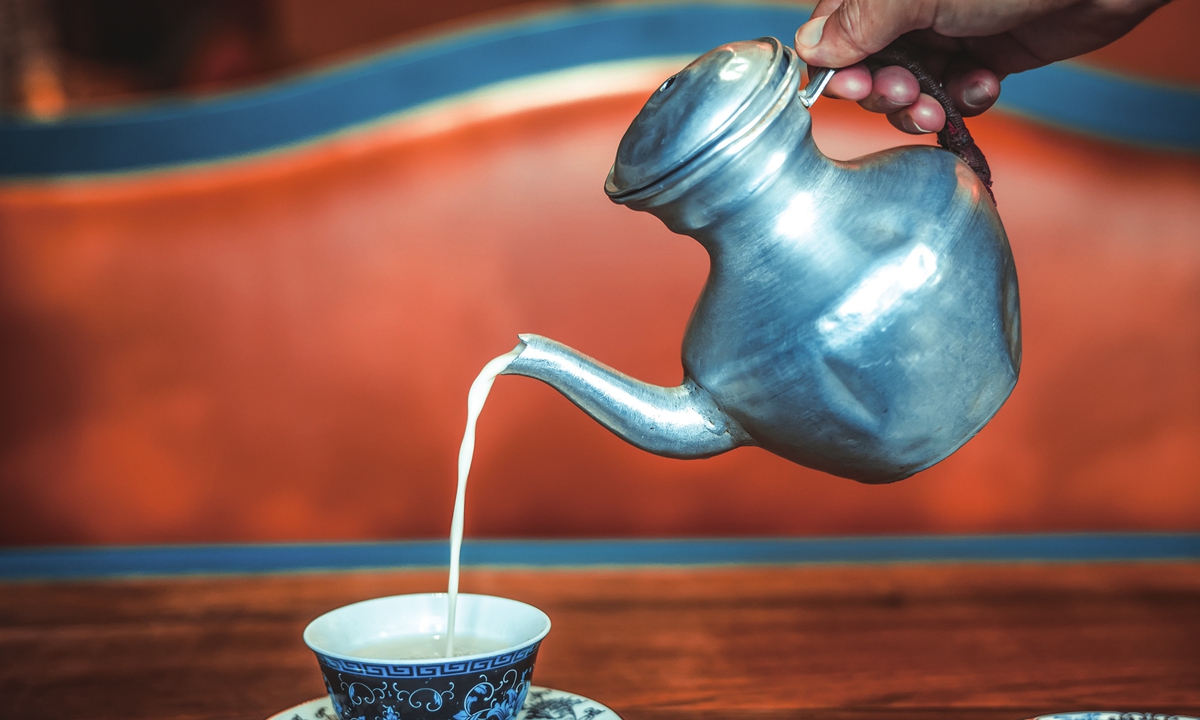
Yak butter tea Photo: VCG

Tibetan-style hot pot Photo: VCG
For those who have never been to Southwest China's Xizang Autonomous Region, the Tibetan cuisine may be a stereotypical idea for them who think it merely consists of very simple diet. In fact, Tibetan cuisine can comprise a diverse array of dishes cooked with the special ingredients from the Qinghai-Xizang Plateau.
Historical transitionBoasting a history of 1,400 years, Tibetan cuisine has undergone four historical stages. It came into being in the 6th century when the Tubo Kingdom carried out extensive economic and cultural exchanges with the Central Plains area. After Princess Wencheng of the Tang Dynasty (618-907) and Princess Bhrikuti from Nepal married to King Songtsan Gambo, they brought to the region new ingredients and cooking skills, which helped enrich Tibetan cuisine.
The second stage can be traced back to the 13th century, when Xizang was formally incorporated into the Chinese territory. In that period, Xizang's close contact with the Mongolian ethnic group influenced its diet.
During the third stage, Xizang enhanced communication with the Qing Dynasty (1644-1911),so new vegetables, together with cooking utensils and skills, were introduced to Xizang.
The fourth stage started from the rise of tourism in the 1980s thanks to China's reform and opening-up. While preserving its traditional food, new ingredients were introduced and the cooking skills of Tibetan gastronomy started being integrated with cuisines of other parts of China and Western countries.
Culinary traditionSince ancient times, people on the Qinghai-Xizang Plateau have mainly lived on highland barley flour, yak beef, yak butter tea, and highland barley wine.
One of the staple foods is Zanba. Mixed with highland barley flour and yak butter tea, Tvorog and sugar, Zanba is both yummy and crispy with a sweet and salty taste. It can provide rich nutrients, calories, and energy for people to resist the cold on the plateau. It is said that pilgrims who carry Zanba in their pockets will never go starving.
Another kind of staple food is Tibetan-style noodles. Made of soda and wheat flour mixed with water, they are characterized by a yellow hue and served in a soup made from yak bones. Together with sweet tea composed of black tea, milk and sugar, a popular drink in Lhasa, and fried pancakes, the Tibetan noodles make a typical Tibetan breakfast.
In Tibetan people's daily life, yak butter tea is something indispensable. As a Tibetan saying goes, "Meals can be skipped in a day, but tea cannot be missed in a meal." Yak butter tea is made from black tea brick and yak butter, a popular drink containing 80 to 90 percent of fat and vitamin A to compensate for the lack of nutrition from vegetables present in the diet. It is also believed that this kind of tea can help relieve high altitude sickness.
Besides, yak butter tea is more a ritual than a drink. Tibetans usually treat guests with three cups as three carries an auspicious meaning. Taking only one cup is seen as taboo. Tea is usually poured to the brim of the cup, and after drinking it, a small part of it must be left in the cup as a courtesy, so it is with the second cup.When the third cup is filled up, however, guests are supposed to drink it all in one go.
High-land barley wine is also a popular Tibetan beverage. It is a must during Tibetan festivals for men and women, the old and the young. After being soaked in cold spring water for a day or two, highland barley is boiled till it is well cooked. When its temperature drops, distiller's yeast is applied, and then it is poured and sealed in pottery pots or wooden barrels for fomentation. After two or three days, water is added, and another one or two days later, the wine is ready to be served. The yellowish beverage is a low alcohol wine similar to beer but with a somewhat sweet taste. At banquets, hosts usually propose toasts to guests while singing Tibetan songs round after round to show their warm hospitality.
In addition, traditional Tibetan food also includes air-dried yak beef known for its low fat and high protein, raw yak meat sauce which goes well with zanba, finger food boiled mutton, Tibetan pork, and yogurt, a delicacy especially for the Shoton Festival every year.
Innovation in preservationSince ancient times, Xizang has kept a close contact with its adjacent province - Sichuan, which is well known for its hot and spicy food. Today, more and more Sichuan-style restaurants can be seen in Xizang, especially in Lhasa. Tibetan cool bean jelly, with a trace of Sichuan cuisine, is only stronger in flavor as its chilly oil is composed of dozens of stirred-fried spices, which can challenge one's palate.
The Tibetan cuisine has also been influenced by the food of Yunnan and Qinghai provinces as well as other countries such as Nepal, India, and the US. Quite a few novel Xizang dishes have been innovated, such as braised Tibetan chicken with matsutake, stewed duck with caterpillar fungus, roasted Tibetan pork, Tibetan hot pot, Tibetan porridge, curry rice, Tibetan "French fries," Khampa steak, and highland barley pizza, which are pleasant surprises for tourists.
"The innovated Tibetan cuisine caters to the needs of different customers. As meat is the most used ingredient in the Tibetan traditional diet, the new Tibetan cuisine endeavors to be more nutritionally balanced. So a lot of people like it," a staffer who has brought many friends from other parts of China to try Tibetan cuisine in Xizang told the Global Times.